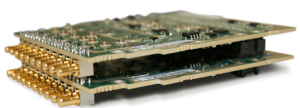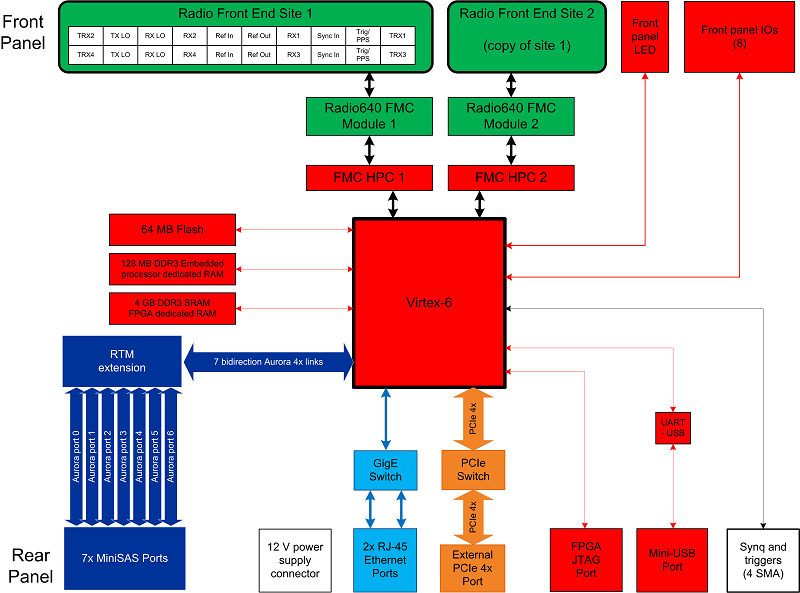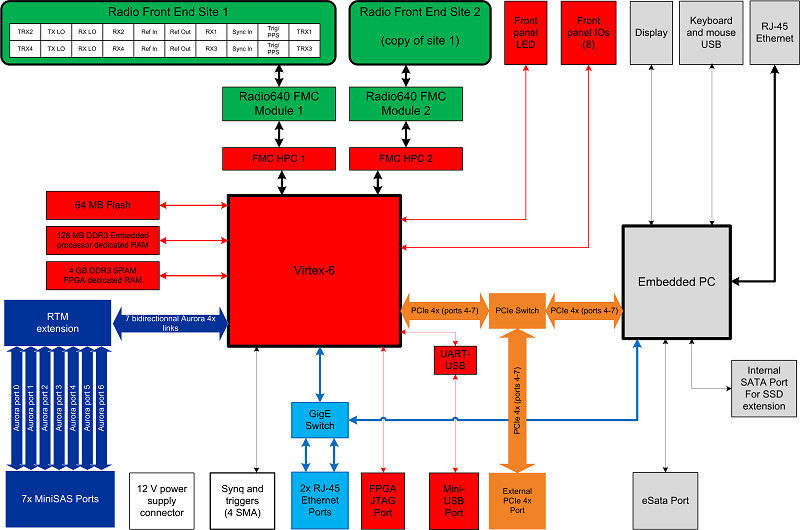Pico SDR 4×4
Key Features:Prototyping is easier than ever with this new 4×4 MIMO SDR platform, with 4 channels perfectly synchronized on one FPGA. Use Simulink to leverage the power of a large Virtex FPGA without writing a single line of HDL code. 70 MHz to 6 GHz on one single radio: Unlock the full performance of the AD9361 across all frequency bands. |
|
|
 |
70 MHz to 6 GHz on one single radioThe PicoSDR 4×4 relies on one single 70 MHz – 6 Ghz radio card, built on the agile and high-performance AD9361 Radio Frequency Integrated Circuit (RFIC), that offers the full performance on all bands frequency. |
|
|

|
Configuration

PicoSDR 4×4

PicoSDR 4×4-E
Pico SDR 8×8
Key Features:Phased-array, beam forming, direction finding and MU-MIMO is now affordable with this new 8×8 MIMO SDR, offering 8 TRx channels per FPGA. With the ability to connect two units for perfectly synchronized 16×16, automatic gain & phase calibration, dedicated links to bring all IQ streams into one master FPGA, building large MIMO systems has never been easier. |
|
|

|
8×8 on one single FPGAClick on the image to enlarge it |
Automatic gain & phase calibration for phased-array, beam forming, direction finding and MU-MIMOHere’s a demonstration of our calibration feature on the TitanMIMO-6, another of Nutaq’s product. |
70 MHz to 6 GHz on one single radio
The PicoSDR 8×8-E relies on one single 0-6 Ghz radio, built on the agile and high-performance AD9361 Radio Frequency Integrated Circuit (RFIC), that offers the full performance on all bands frequency.
- RF 2×2 transceiver with integrated 12-DACs and ADCs
- 70 MHz to 6 GHz frequency range with integrated fractional-N synthesizers (2.4 Hz maximum LO step size)
- Supports TDD and FDD operation
- Tunable channel bandwidth: 200 kHz to 56 MHz

- Receiver sensitivity with a typical noise figure of 7 dB from 200MHz to 4 GHz and 10dB from 70MHz to 6 GHz
- 100dB RX gain control with real-time monitor and control signals for manual gain
- Independent automatic gain control
- TX OP1dB : +18dBm from 200-4000MHz and +10dBm from 200-6000MHz
- Highly linear broadband transmitter (TM3.2 20MHz-16QAM LTE signal):
- ACPR: typically -45dB for +10dBm and 0 dBm at 2.4GHz and 5GHz respectively
- EVM: 2.5% and 3.5% typically for +10dBm and 0 dBm at 2.4GHz and 5GHz respectively
- TX noise: ≤−150 dBm/Hz noise floor
- 100dB+ TX gain control with 31dB external gain control
Configurations
SDR Comparison Chart
| PicoSDR 4×4 or 4×4-E | PicoSDR 8×8 or 8×8-E | ||
|---|---|---|---|
| Antenna Configuration | |||
| Transceiver Configuration | 4×4 MIMO | 8×8 MIMO | |
| Radio Configuration | |||
| Carrier frequency | 56 MHz to 6 GHz | 56 MHz to 6 GHz | |
| OTA RF Bandwidth | 200 kHz to 56 MHz | 200 kHz to 56 MHz | |
| Processing Solutions | |||
| FPGA | Xilinx Virtex-6 x2 | Xilinx Virtex-6 x2 | |
| CPU | External PC or embedded Quad-Core i7 | External PC | |
| Software Tools | |||
| Model-based design (Simulink) | Yes | Yes | |
| GNU Radio (external & embedded) | Yes | Yes | |
| Data Communication Transfer | |||
| PCIe | Yes | Yes | |
| GigE | Yes | Yes | |
| Aurora Point-to-Point | Yes | Yes | |
| Form Factor | |||
| Dimensions | 48.05 mm x 215 mm x 290 mm | 45 mm x 365 mm x 378 mm) | |
| Weight | 2.4 kg (4×4) / 3.0 kg (4×4-E) | 5.0 kg (8×8) / 5.6 kg (8×8-E) | |
| Power Consumption | 4×4: 35W 4×4-E: 60W |
8×8: 61W 8×8-E: 86W |
|



